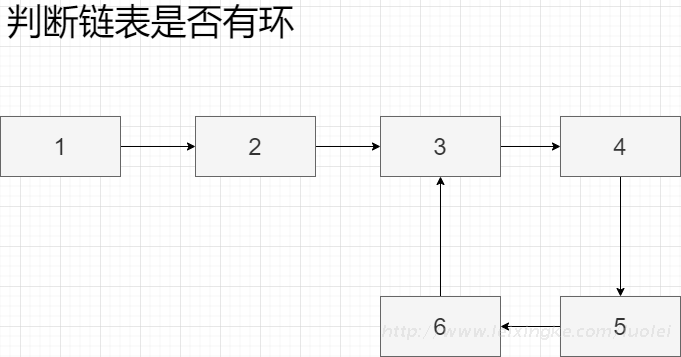给定一个链表,如果它是有环链表,实现一个算法返回环路的开头节点。
有环链表的定义:在链表中某个节点的next元素指向在它前面出现过的节点,则表明该链表存在环路。

复制收展Javapackage com.algorithm.list;
/**
* @Desc 累行客
* 单链表结构
* @Author luolei
* @Web http://www.leixingke.com/
* @Date 2020/11/07 15:06
*/
public class ListNode<T>{
T item;
ListNode next;
/*构造函数*/
ListNode(T item){
this.item=item;
this.next=null;
}
/*添加新的结点*/
public void add(T item) {
if(this.next == null) /*如果当前结点的next为空,直接指向新结点*/
this.next = new ListNode(item);
else /*如果当前结点的next不为空,向后扫描,直到遇到next为null的结点,将新结点插入*/
this.next.add(item);
}
/*打印链表*/
public void print() {
System.out.print(this.item);
if(this.next != null) {
System.out.print("--->");
this.next.print();
}else{
System.out.println();
}
}
}- 1
- 2
- 3
- 4
- 5
- 6
- 7
- 8
- 9
- 10
- 11
- 12
- 13
- 14
- 15
- 16
- 17
- 18
- 19
- 20
- 21
- 22
- 23
- 24
- 25
- 26
- 27
- 28
- 29
- 30
- 31
- 32
- 33
- 34
- 35
- 36
1、判断单链表是否有环
2、返回环的入口
复制收展Javapackage com.algorithm.list;
/**
* @Desc 累行客
* 判断单链表是否有环
* 给定一个链表,如果它是有环链表,实现一个算法返回环路的开头节点。
* 有环链表的定义:在链表中某个节点的next元素指向在它前面出现过的节点,则表明该链表存在环路。
* @Author luolei
* @Web http://www.leixingke.com/
* @Date 2020/11/07 14:34
*/
public class hasCycleSolution {
/**
* @Desc: 判断单链表是否有环 快慢指针遍历法
* 思路:定义两个指针 fast 和 slow,两者初始指向链表头,slow每次前进一步,fast每次前进两步。
* 快指针能不能继续往下走 fast != null && fast.next != null
* 如果有环,那么快指针一定能追上慢指针,若 slow 和 slow 在某时刻指向同一结点,则说明该链表有环。
*
* 快慢指针,当快慢指针相遇时,快指针比慢指针多走了环长度的整数倍,而且快指针比慢指针多走的多走的和慢指针走的一样,
* 所以慢指针走的步数也是环长度的整数倍!此时让快指针再从头走,速度和慢指针一样,两指针肯定会在环入口相遇。
*
* 1--->2--->3--->4--->5--->6
* --->3--->4--->5--->6
* ...
* --->3--->4--->5--->6
*
* @param head:
* @return: boolean
*/
public static boolean hasCycle(ListNode head) {
if(head == null || head.next == null) return false;
ListNode slow=head;
ListNode fast=head;
while (fast != null && fast.next != null) {
slow=slow.next;
fast=fast.next.next;
if(slow == fast) return true;
}
return false;
}
/**
* @Desc: 返回环的入口
* 快慢指针,当快慢指针相遇时,快指针比慢指针多走了环长度的整数倍,而且快指针比慢指针多走的多走的和慢指针走的一样,
* 所以慢指针走的步数也是环长度的整数倍!此时让快指针再从头走,速度和慢指针一样,两指针肯定会在环入口相遇。
* slow 和 fast
* 第一次相遇说明有环
* 第二次相遇即是环入口
* @param head:
* @return: com.algorithm.list.ListNode
*/
public static ListNode detectCycle(ListNode head) {
if(head == null || head.next == null) return null;
ListNode slow=head;
ListNode fast=head;
while (fast != null && fast.next != null) {
slow=slow.next;
fast=fast.next.next;
/*第一次相遇说明有环*/
if (slow == fast) {
fast = head;
/*第二次相遇即是环入口*/
while (slow != fast) {
slow = slow.next;
fast = fast.next;
}
return slow;
}
}
return null;
}
public static void main(String[] args) {
/*创建链表,第一个结点*/
ListNode ln = new ListNode(1);
ln.add(2);
ln.add(3);
ln.add(4);
ln.add(5);
ln.add(6);
/*创造环*/
ListNode node = ln.next.next.next.next.next;
node.next=ln.next.next;
/*判断是否有环*/
System.out.println(hasCycle(ln));
/*环入口*/
System.out.println(detectCycle(ln).item);
/*输出*/
ln.print();
}
}- 1
- 2
- 3
- 4
- 5
- 6
- 7
- 8
- 9
- 10
- 11
- 12
- 13
- 14
- 15
- 16
- 17
- 18
- 19
- 20
- 21
- 22
- 23
- 24
- 25
- 26
- 27
- 28
- 29
- 30
- 31
- 32
- 33
- 34
- 35
- 36
- 37
- 38
- 39
- 40
- 41
- 42
- 43
- 44
- 45
- 46
- 47
- 48
- 49
- 50
- 51
- 52
- 53
- 54
- 55
- 56
- 57
- 58
- 59
- 60
- 61
- 62
- 63
- 64
- 65
- 66
- 67
- 68
- 69
- 70
- 71
- 72
- 73
- 74
- 75
- 76
- 77
- 78
- 79
- 80
- 81
- 82
- 83
- 84
- 85
- 86
- 87
- 88
- 89
- 90
- 91
- 92
- 93
- 94
- 95
- 96
- 97
- 98
扩展


